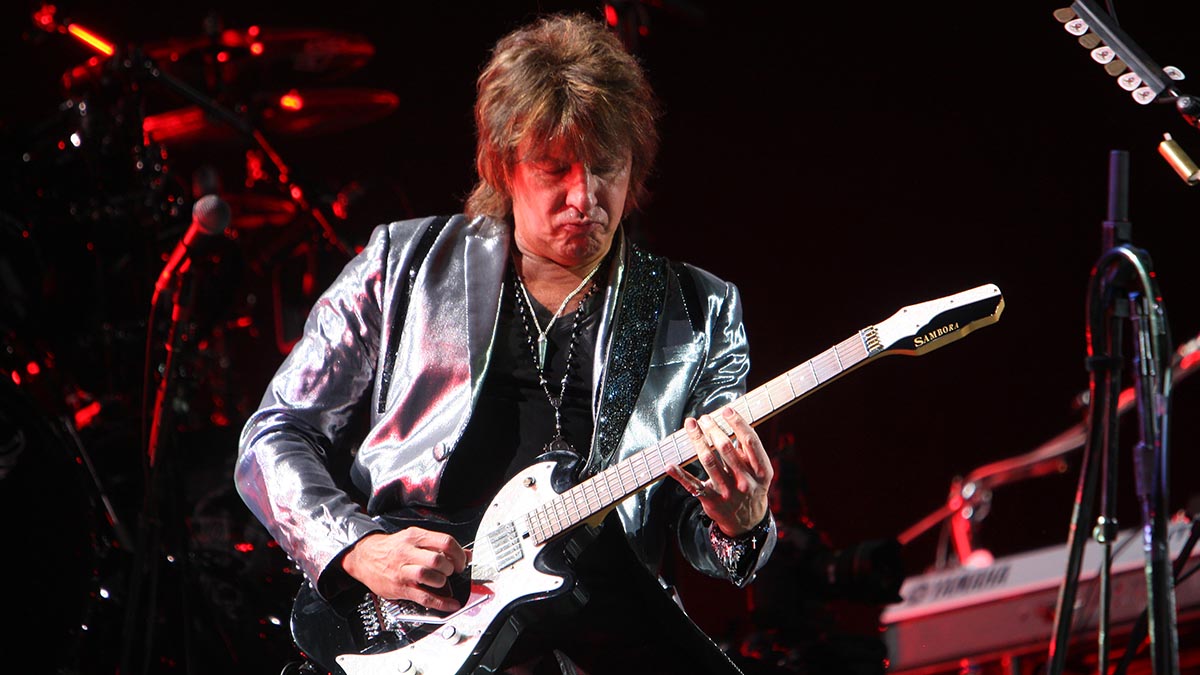Richie Sambora has a supersized blues soloing style – make your solos more melodic by learning his lead guitar tricks
The megastar guitarist behind Bon Jovi's mega-selling hits, Sambora has an effervescent approach to blues. We unpack his melodic pentatonic approaches

Few bands have been as iconic and timeless as the great Bon Jovi. Bringing the 1980s era of hair metal to the masses with their radio-friendly anthems, Bon Jovi paved the way for huge choruses, tight leathers and gratuitous guitar solos. While the band took its name from the legendary frontman himself, Bon Jovi was far from the solo act that some people assume.
Richie Sambora joined the band in 1983 and was instrumental in the group’s success, being one of its main songwriters and producers for 30 years. As well contributing his iconic guitar solos to their greatest hits, he was also responsible for crafting the songs themselves. Richie is credited as having co-written their biggest anthems including Living on a Prayer, You Give Love a Bad Name, Bad Medicine and many other iconic and mega-selling hits.
In Bon Jovi, Richie’s playing is soulful and melodic, interspersed with moments of ’80s-style shred guitar. It’s clear on listening to the construction of his solos that Richie has a strong producer’s ear, with each solo being exactly what is needed for the song: melodic and catchy, with just enough technical flair to keep the guitar nuts happy.
As well as a successful career in Bon Jovi, Richie has also had a notable solo career, having released three albums featuring his own songs and vocal work. He’s composed music for television and film, and has been invited as both a guest vocalist and guitarist on a number of records with a diverse range of artists like LL Cool J, Bo Diddley, Stuart Smith, P!nk and Orianthi among them.
Like many great rock players of his era, Sambora is well versed in the art of blues guitar. Growing up in the ’70s, he was inspired by the likes of Jimi Hendrix, Eric Clapton, Jeff Beck, Stevie Ray Vaughan, Jimmy Page, B.B. King and many other legends of the genre. Undoubtedly, this is where Richie picked up his brilliant sense of phrasing and musicality; his solo albums contain wonderfully rich, earthy blues-rock tracks with soulful vocals, as well as his ’80s-style commercially informed music.
There’s lots that we can take away from Richie’s iconic style, like his sense of melody and the compositional approach to his solos. Our two studies focus on his rocky blues side, exploring his use of classic blues-based vocabulary to break up his melodic ideas and add fire and expression to the overarch all of his compositions.
Get the tone
Amp Settings: Gain 7, Bass 5, Middle 5, Treble 5, Reverb
All the latest guitar news, interviews, lessons, reviews, deals and more, direct to your inbox!
Although best-known for using hot-rodded Strat style guitars into modified Marshall amps, these days Richie plays his ESP signature guitars through Friedman amps. Any good electric guitar will work for our two tracks, but you’ll need a fair amount of drive, so a good distortion into a Brit-style amp sound is perfect. Add a nice reverb or smooth delay pedal for that final touch.
Solo 1. Melodic blues-rock
This is a great example of Richie’s melodic lead work, interspersed with some Hendrix-style double-stops to break up scalic nature of the solo.
Solo 2. Mixing up the scales
This study features the use of two pentatonic scales in one key. The track itself is in D major, but the first half pedals around the II chord of E minor, giving us a Dorian tonal centre. This then releases into the parent key of D major.
To employ Richie’s blues-rock based phrasing we use E minor pentatonic vocabulary over the first half and then switch to D major pentatonic for the second half, with other melodic ideas drawn from the D major scale itself.
Phil Short is a sought-after guitarist from the UK. A stadium player, Phil is well known for his technically accomplished guitar style and has showcased his talent touring with Irish boyband Westlife. As well as touring, Phil has been a visiting lecturer at BIMM London since 2017, teaching performance, technique and improvisational skills to the next generation of guitarists. Phil is a monthly contributor for Guitar Techniques magazine, writing the blues column as well as video features on iconic rock legends.

